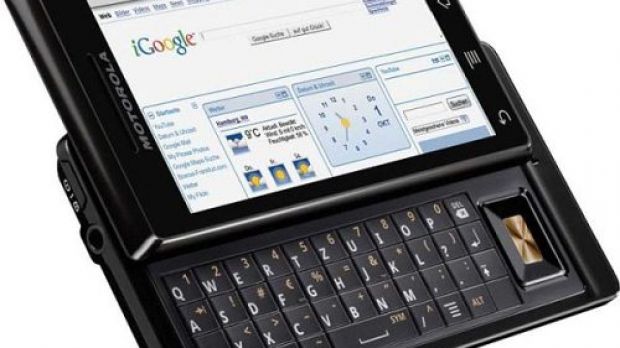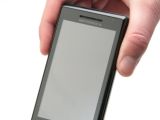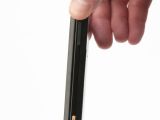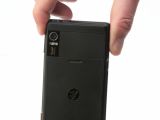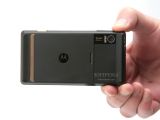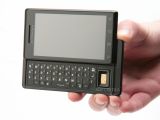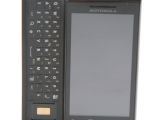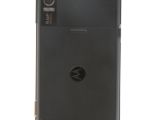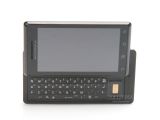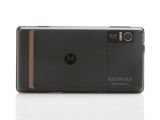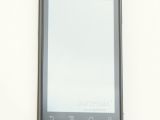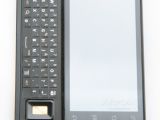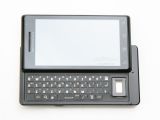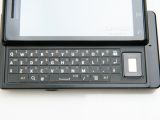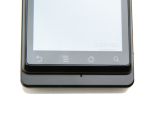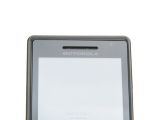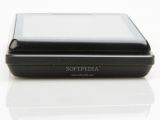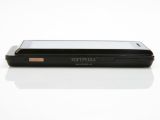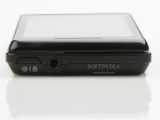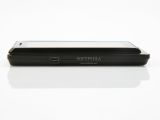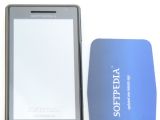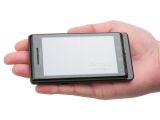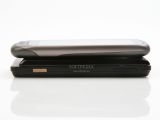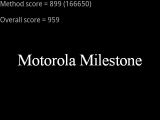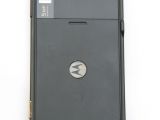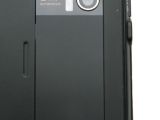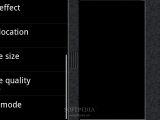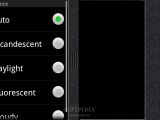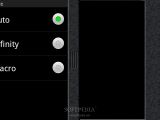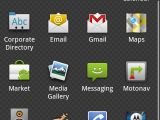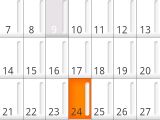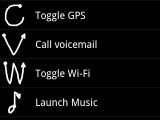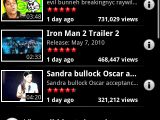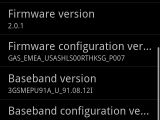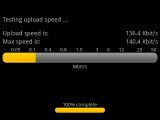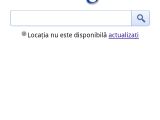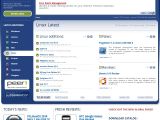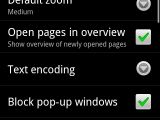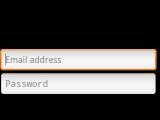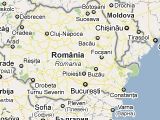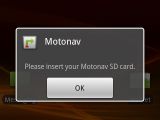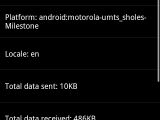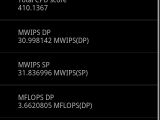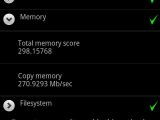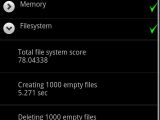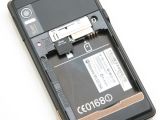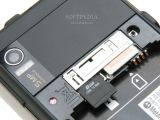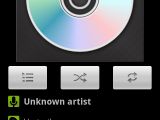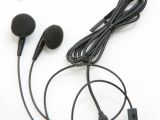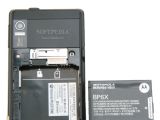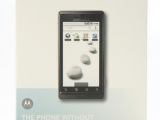After successfully launching its first Android smartphone Motorola DEXT (or CLIQ in the United States), Motorola's put its high hopes for financial recovery onto its next Android device – Milestone (DROID for the United States). Even though DEXT didn't have a blast in sales, it has been well received by users and registered pretty good sales. Still, to be able to recover from the huge drop in profits, the mobile division of Motorola needs to come up with something that will sell extremely well for a much longer period. With that in mind the company decided to bet on Android OS again and invested in yet another smartphone, which later on will become the first to be shipped with Android 2.0 version. Following the same marketing politics, Motorola launched two versions of the device, bearing somehow different firmwares and features: Motorola Milestone, available in Europe and Motorola DROID, especially developed for users living in the US. We will be discussing about the European version of the smartphone, namely Motorola Milestone.
The smartphone was announced in November 2009 and released at the same time, but depending on location, the device may reach you later. There are no additional colors available, so you will have to get used to the Black color. The unlocked version of Motorola Milestone can be bought for a price ranging from 560USD to around 600USD, depending on your location.
DesignMotorola Milestone is yet another QWERTY slider, that seems to emulate the first device carrying Android OS – T-Mobile G1. As a side note, Motorola Milestone is the first device to ship directly with Android 2.0, so you won't need to make the update from 1.5 or 1.6 versions. The smartphone seems to have a solid build, as it includes lots of metallic parts. This proves that Motorola hasn't done any compromises regarding the phone's design and used only some of the best materials it could. That totally removed the feeling of cheapness that the G1 had because of the low quality plastic used for its manufacturing. The front part of the device is mostly represented by the huge 3.7-inch touchscreen.
The innovation comes from the fact that the front part is a little smaller than the back part of the device. I'm not sure of the reason, but I noticed that the mic has been placed on the small space between the front and back part of the device, right in the middle. Milestone measures 115.8 x 60 x 13.7 mm and weighs 165g (including battery). This is a phone quite big and heavy, but it's no wonder as it's almost completely covered by metallic parts. Still, the device feels great in hand as it's very well-balanced and slimmer than most other sliders carrying full QWERTY keyboards. Motorola's Milestone front part is "clean" and will not catch too many fingerprints, even though you will use your fingers on the touch screen. Just above the display there's a small ambient light sensor, while below the screen there are four touch sensitive keys. Apart from the fact all four keys benefit from the haptic feedback feature, they are very responsive, unlike the lastest Google Nexus One. It seems that these four keys tend to become a standard for all smartphones running Android OS: Back, Menu, Home and Search. The right side of the phone features a dual volume key and a dedicated camera key, while on the left side, there's a microUSB port. The power button, which can also be used to lock the screen, as well as a 3.5mm port jack have been placed on top of the phone. To check out the QWERTY keyboard you will need to slide the phone to the left. That will reveal a four-row keyboard and a big directional pad (D-pad). Even though I had the impression that the D-pad was touch sensitive, at a closer look I noticed that it was not. The keyboards layout makes texting a real pleasure. Keys are well-spaced and responsive, backlighting is excellent, so no drawbacks here. With the help of the D-pad, users will be able to control the smartphone without needing to touch the capacitive touchscreen. This comes in handy especially when using the browser, even though the display features the multi-touch function. The 5-megapixel camera on the back of the phone also features dual LED flash, while at the bottom of the battery cover one can notice a large loudspeaker grid. The back cover is easy to pull out and is metallic made, which ensures some extra safety measures against casual drops or scratches. If you're looking for a microSD port, you will need to pull out the back hood of the phone. The port can be found near the SIM card slot and it's not hot-swappable.Overall, I think Motorola did a great job when they designed Milestone and the fact that they chose a durable metallic compound to manufacture it proves a high level of commitment.
Display and CameraMotorola Milestone includes a huge 3.7-inch capacitive touchscreen that supports 480x854-pixel resolution and 16 Million colors. The capacitive touchscreen is very responsive and snappy. Thanks to the technology embedded, it eliminates the need for a stylus and makes your own finger the only way to control your device on the screen. Colors are bright and vivid, contrast is excellent and sunlight eligibility within the parameters.
The accelerometer works with most of the applications and menus. Your display won't turn to landscape mode when you're on Homescreen or in the main menu. The image quality is astonishing if you set the brightness almost to maximum, which will probably drain your battery much faster. The change between landscape and portrait mode is almost instant with no hiccups. Everything you do seems natural when using the touchscreen: touching, dragging, or moving. If you don't like typing on the QWERTY keyboard, you can use the included virtual on-screen keyboard, also very easy to type on. Features like kinetic scrolling and pinch zooming are working smoothly and enhance the user’s browsing experience. Check out the benchmark results for a better view of the display's performance. The 5-Megapixel camera features a dual LED flash and minor upgrades, compared to other Android devices: digital zoom, scene mode, white balance, color effects and macro focus mode. It might sound strange, but these features have become standard long ago for all the other mobile phones, yet only some Android smartphones are getting it for now. Let's hope for future upgrades regarding the camera module. The maximum resolution that can be used to take pictures is 2592 x 1944 pixels. The user interface is pretty simple without any complex settings and can be browsed by touch. The shutter of the phone is the dedicated button on the right side of the phone or you can use the touch shutter that appears in the right corner of the camera interface. Both are responsive enough and can be used with ease together with the autofocus feature. Users will be able to record D1 clips (720x480 pixels) at 30fps, which has also become standard for Android devices. There's not much to discuss about quality, just that all clips are recorded in 3gp format, which might suggest some low quality results. Overall, I think the 5-megapixel camera takes decent pictures for an Android smartphone that is not focusing exclusively on its camera module. Menu and SoftwareMilestone is the first smartphone that ships with Android 2.0, but this has now become obsolete as a new 2.1 version has also been deployed on most of the Android compatible devices. Sadly, Motorola is not capable to deliver the new update of the operating system yet, but it seems a beta version has already been deployed for testing. The update that entered the testing phase is only available for DROID users, while Milestone users will probably receive the upgrade much later this year. Anyway, the changes between the versions 1.5, 1.6 and 2.0 are consistent and make the operating system more reliable, efficient, and they also add quite a high number of features that were initially skipped.
Contacts improvements: Multiple accounts can be added to a device for email and contact synchronization, including Exchange accounts; Quick Contact for Android provides instant access to a contact's information and communication modes. Email improvements: Exchange support; Combined inbox to browse email from multiple accounts in one page. Messaging improvements: Search functionality for all saved SMS and MMS messages. Camera improvements: Built-in flash support, Digital zoom, Scene mode, White balance, Color effect, Macro focus. Browser improvements: Refreshed UI with actionable browser URL bar enables users to directly tap the address bar for instant searches and navigation; Bookmarks with web page thumbnails; Support for double-tap zoom; Support for HTML5. Input method improvements: An improved keyboard layout makes it easier to hit the correct characters and improve typing speed; The framework's multi-touch support ensures that key presses aren't missed while typing rapidly with two fingers; A smarter dictionary learns from word usage and automatically includes contact names as suggestions. Calendar improvements: Agenda view provides infinite scrolling; Events indicate the attending status for each invitee; Invite new guests to events. Media Framework improvements: Revamped graphics architecture for improved performance that enables better hardware acceleration. Bluetooth improvements: Bluetooth 2.1; New BT profiles: Object Push Profile (OPP) and Phone Book Access Profile (PBAP). The phone lacks HTC's Sense UI, but I don't see it as a drawback. Motorola Milestone comes with three available Homescreens, which can be populated with a wide range of widgets: Analog clock, Calendar, Facebook, Music, News and Weather, Picture frame, Power control, Search and YouTube client. The transition between them is fast and smooth. The standard Homescreen includes the Google search bar and a few shortcuts under: Messaging, Market, Phone, Contacts, Browser and Maps.There's also a dedicated YouTube video player, which gives you a fast access to clips hosted by YouTube. Other pre-installed applications include Alarm Clock, Audio Effects, Browser, Calculator, Calendar, Corporate Calendar, Corporate Directory, Market, Maps, Media Gallery, Messaging, Motonav, Music, My Sign, Phone, Phone Portal, Settings, SIM Toolkit and Gtalk. As you can notice, there's no document viewer pre-installed, but the market can offer some free options. Of course, you will only be able to read documents, but if you want to be able to edit documents, you will have to pay. The same goes for the PDF reader, which is missing.
Overall, browsing through the menu was a real pleasure, as the phone acts snappy and smooth. The main cause may be the lack of a more demanding graphical user interface.Communication
Motorola Milestone benefits from all possible connectivity tools that should be included in a high-end device: GPRS and EDGE class 12, HSDPA 10.2 Mbps and HSUPA 5.76 Mbps, Wi-Fi 802.11 b/g, Bluetooth 2.1 with A2DP, microUSB 2.0. As you can see from the tests below, the device reached speeds of up to 645 Kbit/s download and 136 Kbit/s upload on the Orange 3G+ network and 160 Kbit/s download and 40 Kbit/s upload on EDGE network. These performances are medium for a device that depends mostly on the data transfer to update its widgets or for fast Internet browsing.
The integrated browser WebKit cannot be closed but has been upgraded in the 2.0 version. You can now take advantage of the multi-touch gestures to quickly zoom in/out. The browsing experience is one of the best embedded into a smartphone, but suffers from the fact that it lacks support for Flash. You can easily browse multiple webpages only using the D-pad if you don't like touch control or are more familiar with Nokia N97 browsing control. The Android smartphone is compatible with all email clients and protocols (POP3, IMAP) and can be synchronized with Microsoft Exchange. The device is also compatible with SMS, EMS, and MMS text features. Instant messaging options include Google Talk, but other IMs can also be installed. The interface is pretty straightforward and user-friendly. The Wi-Fi 802.11 b/g connectivity is another option that will surely reduce costs for those that are heavily using Internet browsing or data transfers. The built-in GPS receiver and digital compass work together with the Google Maps, so that you won't get lost. Even though you won't be able to take advantage of the vocal navigation, unless you live in the States, Google Maps can offer you the rest of the features for free: routes, localization etc. Besides the Google Maps application, Milestone also offers its users the Motonav application, which can be used for navigation. Unfortunately, you will have to pay to register the application and use its voice guide navigation feature. Motorola Milestone is a quad-band GSM (850 / 900 / 1800 / 1900) handset that is also compatible with HSDPA 900/2100 networks. The in-call sound quality is pretty decent, a little better than HTC devices as it benefits from Motorola's CrystalTalk technology, which can be enabled/disabled. The GSM signal is also good, but avoid keeping the gadget set on the 3G band, as it will drain your battery.Processor and Memory
Motorola Milestone is powered by a single ARM TI OMAP3430 600 MHz processor. Apparently, the CPU has been underclocked to function up to 550 MHz, which means the battery won't drain so fast. That doesn't mean that your phone will be slower. I haven't experienced any freezes, as the device has smooth transitions between windows and functions perfectly even when multiple applications are open.
The smartphone embeds 256 MB RAM and 512 MB ROM memory. The storage space can be expanded up to 32GB through the microSD slot card that has been placed under the back cover. The sales package also contains an 8GB microSD card. MultimediaUnfortunately, Milestone hasn't been improved in terms of multimedia features, so don't expect too much. Even if the included MP3 player features a stylish interface, you won't be able to enjoy extra options such as equalizers or visualization effects. The only improvement that can be easily noticed is the added 3.5mm jack port on the top side of the phone. Thus, you will now be able to add your own headphones for a better music playback experience.
The music player supports audio files in MP3, eAAC+, WAV and WMA9. The music sound is pretty decent even if you don't have any special effects. The video player that appeared for the first time into Magic's firmware is also present in this model, but do not look for it in the menu. The video player will open itself every time you click on a video file and it supports MP4, WMV9, H.263 and H.264 files. Milestone does a decent job as an MP3 player, as it offers some nice features for those who want to casually listen to some music or watch a short movie. Unfortunately, limited support for encoded movie files, lack of DivX or XviD support makes the huge display rather pointless. BatteryThe smartphone includes a 1400 mAh Li-Ion battery, which has an officially stated life expectancy of 350 hours in standby (380 hours for 3G network) and 6 hours and 30 minutes in talk-time mode (4 hours and 50 minutes for 3G network). Even though it's a big capacity battery our test unit made it for about 2 days, with medium use (40 minutes of talking, 20 minutes music playback and about 20 minutes of Internet browsing). Of course, the autonomy of the battery can be prolonged by decreasing the brightness, as well as keeping your phone on EDGE network all the time, and disabling live background data. You will be able to check the level of the battery as usual, but the device seems to display the level of energy from 10 to 100%. Overall, the battery is pretty decent, energy consumption being much better optimized than Nexus'.
ImpressionsMotorola Milestone is definitely one of the best smartphones manufactured by the American company and will fiercely compete HTC's Android devices. The similar device in its range seems to be HTC Touch Pro2 and Nokia N900, but users will most likely take into consideration the operating system that each of these devices are running. If you are into Android smartphones and also like to type on a full QWERTY keyboard, Motorola Milestone is a very good choice. The only thing I'm afraid of is Motorola's support, which doesn't seem up to the level of this device. Anyway, I enjoyed using the Milestone, which could be a complete Android solution as soon as version 2.1 of the operating system will be pushed over-the-air to end users' devices.
The Good
The Bad
Sales Package
Motorola Milestone smartphone; Stereo headset; 8GB microSD Card; 1400 mAh Li-Ion Battery; Charger; microUSB Cable; Software CD; Manual.

 14 DAY TRIAL //
14 DAY TRIAL // 